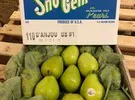U.S. growers anticipate a strong close to an equally strong fall season on pears.
“It’s a high-quality crop this year of pears,” says Dawson Williams of Williams & Lu LLC in Frederick, MD.
He notes that there’s a healthy amount of good-quality extra fancy #1 fruit. “In those supplies, it looks really good. If you want lower grades, it’s more of a challenge because they got a really good finish and sales have been pretty swift moving Anjou, Bartlett and other varieties,” says Williams. “It’s been a solid year. Not a super abundant crop, but a solid one.”
Contributing to the good season was the hot summer the region experienced. “It was good early growing conditions,” says Williams. “And it’s coming off of a cycle from the previous year where the quality wasn’t as good.”
Similar volumes  Williams anticipates the crop to go until early spring when it usually wraps up. He also adds that overall volume this year is relatively even with last year’s supplies.
Williams anticipates the crop to go until early spring when it usually wraps up. He also adds that overall volume this year is relatively even with last year’s supplies.
Contributing to the strength is the healthy demand for pears. “Fruit in general started off a little slow in August. I think there was a large carry over from the Northern Hemisphere crop,” he says. “But things got very busy towards the end of October and then November and then we’re into Christmas.” He notes that for export markets such as Central America where Williams & Lu ships to, there’s good holiday demand for commodities such as pears and apples.
Altogether, that’s pushed pricing up slightly on some segments of the commodity, namely fancy-grade pears. “That’s because the lower grades are not so common and certain sizes—there are a lot of middle-sized pears for example,” he says. “Some growers don’t have a lot of 110s and 120 sizes. If they wanted to take a lower grade and it’s not there, that’s pushed prices for the fancy.”
For more information:
Dawson Williams
Williams & Lu LLC.
Tel: +1 (571) 405-8507
dawson@williams-lu.com
